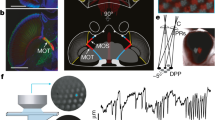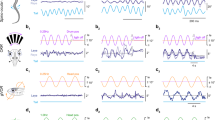Abstract
The principal eyes of jumping spiders (Salticidae) possess a unique visual apparatus1 of unknown phylogenetic origin. Their retinas, with four axial tiers of receptive segments, lie at the end of long, motile tubes2 and have the transverse profiles of narrow, vertical 'boomerangs' with very small horizontal acceptance angles. No other ocellar retina resembles them, and no evolutionary pathway for the transition between the simple, hemispherical monolayers of receptors found elsewhere and the sophisticated jumping spider eye has been proposed. We show that the post-embryonic morphogenesis of a principal retina may explain how it evolved. Conformational changes generate the narrow retinal mosaics from a hemisphere of presumptive receptive segments with hexagonal packing and irregular microvilli distributed around their perimeters much as they are in the retinas of more primitive spiders3. Tiering is a consequence of the conformational change. Our explanation has significant implications for the evolution of the Salticidae.
This is a preview of subscription content, access via your institution
Access options
Subscribe to this journal
Receive 51 print issues and online access
$199.00 per year
only $3.90 per issue
Buy this article
- Purchase on Springer Link
- Instant access to full article PDF
Prices may be subject to local taxes which are calculated during checkout
Similar content being viewed by others
References
1. Land, M. F. /. exp. Biol. 51, 433–470 (1969). 2. Land, M. F. J. exp. Biol. 51, 471–493 (1969). 3. Blest, A. D. The Neurobiology of Arachnids (ed. Barth, F. G.) 79–102 (Springer, Berlin, 1985). 4. Williams, D. S. & Mclntyre, P. Nature 288, 578–580 (1980). 5. Blest, A. D., Hardie, R. C, Mclntyre, P. & Williams, D. S. /. comp. Physiol A 145,227–239 (1981). 6. Jackson, R. R. & Blest, A. D. /. exp. Biol. 97, 441–445 (1982). 7. Wanless, F. R. Bull. Brit. Mus. not. Hist. Zool. 46, 135–205 (1984). 8. Blest, A. D. & Sigmund, C. Proc. R. Soc. B 221, 111–125 (1984). 9. Blest, A. D. & Sigmund, C. Protoplasma 125, 129–139 (1985). 10. Blest, A. D. & Price, G. D. Protoplasma 120, 172–184 (1984). 11. Blest, A. D. /. comp.,Physiol. A 157, 391–404 (1985). 12. Homann, H. Z. Morph. Tiere 69, 201–272 (1971). 13. De Beer, G. R. Embryos and Ancestors 3rd edn (Oxford University Press, 1958). 14. Blest, A. D. Phil Trans. R. Soc. B (in the press). 15. Blest, A. D. & Carter, M. Phil. Trans. R. Soc. B (in the press). 16. Eakin, R. M. & Brandenburger, J. J. Ultrastruct. Res. 37, 618–663 (1971). 17. Jackson, R. R. & Blest, A. D. /. Zoo/. Land. 196, 255–293 (1982). 18. De Voe, R. D. / gen. Physiol. 66, 193–208 (1975). 19. Yamashita, S. & Tateda, H. / comp. Physiol. A 105, 29–41 (1978). 20. Yamashita, S. & Tateda, H. J. exp. Bio/. 74, 47–58 (1978). 21. Uehara, A., Toh, Y. & Tateda, H. Cell Tiss. Res. 182, 81–91 (1977). 22. Blest, A. D., Mclntyre, P. & Carter, M. J. comp. Physiol. (in the press).
Author information
Authors and Affiliations
Rights and permissions
About this article
Cite this article
Blest, A., Carter, M. Morphogenesis of a tiered principal retina and the evolution of jumping spiders. Nature 328, 152–155 (1987). https://doi.org/10.1038/328152a0
Received:
Accepted:
Issue Date:
DOI: https://doi.org/10.1038/328152a0
This article is cited by
-
Prey preferences ofPortia fimbriata, an araneophagic, web-building jumping spider (Araneae: Salticidae) from Queensland
Journal of Insect Behavior (1996)
-
Comparative ultrastructure of Layer I receptor mosaics in principal eyes of jumping spiders: the evolution of regular arrays of light guides
Cell and Tissue Research (1990)
Comments
By submitting a comment you agree to abide by our Terms and Community Guidelines. If you find something abusive or that does not comply with our terms or guidelines please flag it as inappropriate.



